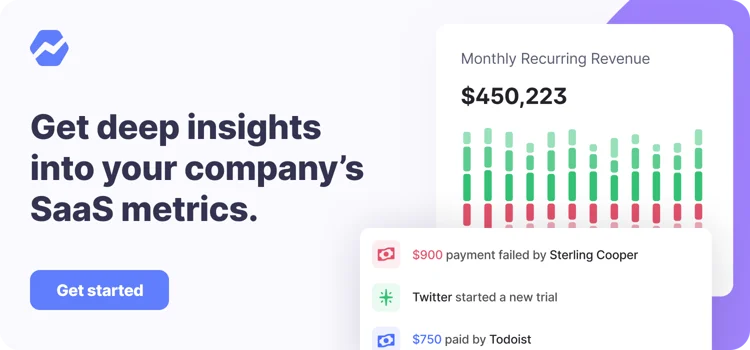Table of Contents

There might not be an industry more addicted to its metrics than SaaS, and there is good reason for it. Coming from data and engineering backgrounds, most SaaS founders know that good decisions require good data, and great decisions require as much good data as you can find.
But how many SaaS financial metrics are you really tracking? Most SaaS companies keep an eye on churn, but do you calculate both revenue churn and customer churn? Most SaaS companies keep track of their customer acquisition cost (CAC) and customer lifetime value (LTV), but how about your CAC:LTV ratio or months to recover CAC?
While the amount of incremental value you get out of each SaaS financial metric is variable, having all of them at your fingertips is one of the keys to success, which is why we are going through all of the SaaS financial metrics in this article.
If you had to calculate them all on your own, you wouldn’t have time to do anything else. That’s where Baremetrics comes in.
Baremetrics does all the heavy lifting for you, intelligently “automating away” meaningless numbers to uncover the true, bigger picture. The crystal-clear dashboard gives you a holistic view of your revenue, expenses, and profit for a specified period. This allows you to quickly spot inconsistencies, eliminate unnecessary waste, and more accurately model your SaaS business’s future based on multiple scenarios.
Baremetrics gives you all the key metrics for your business, including MRR, ARR, LTV, total customers, and more.
Sign up for the Baremetrics free trial and start monitoring your subscription revenue accurately and easily.
What are metrics?
Metrics are all the little mathematical shortcuts you can take to get a good idea of how your business is doing. While collecting and pulling the data to calculate metrics isn’t easy, the metrics themselves are usually based on some pretty simple and logical math. That’s one of the things that make them so powerful.
By boiling down some difficult questions about the health of your business to a number, you can get some insight into how you are doing at the moment or how your situation is changing over time.
For example, if you are worried about the cash flow of your business over the next few months, a quick look at your current ratio or quick ratio will tell you if things are all right or you have something to be genuinely concerned about. While the traditional and GAAP-approved metrics are important for SaaS as well, there are always specific SaaS financial metrics for every occasion, including the SaaS quick ratio.
So let’s look at the simple logic and numbers that go into many of the SaaS financial metrics, and the deep insights your company can get out of them.
Revenue and expense metrics
i. Monthly/annual recurring revenue (MRR/ARR)
ARR and MRR are the bread-and-butter SaaS financial metrics. When you are earning revenue using a subscription revenue model, then you better know how much in subscription revenue you are bringing in!
ARR and MRR are simply the amount of revenue you are bringing in from subscribed customers based on how much they spend per year and month, respectively.
When forward looking, you need to incorporate things like your expected churn, expansion ARR/MRR, reactivation ARR/MRR, and contraction ARR/MRR based on the averages and trends you’ve been seeing recently. However, the basic calculations for current ARR/MRR are pretty easy: ARR/MRR = total number of active customers × average billed amount (over one year/month).
ii. Average revenue per user (ARPU)
This is the average amount a user is paying you per specified period (usually monthly). This can help you keep track of whether your customers are signing up for more services over time, an indication that you are developing services of value to your current customers.
iii. Average cost of service (ACS)
While CAC discussed below is a greater concern to most SaaS businesses, developing and running services isn’t free. If you aren’t aware of how much money you are spending getting your product to market and then running it, you are probably undercharging the real cost of your product.
R&D amortization (per customer, per period), technical support, hosting, account management, and all the overhead spent to run the company must be earned back through subscription revenue, which means you need to include it in this calculation.
iv. Cost of customer acquisition (CAC)
While ACS is often overlooked, most companies are keenly aware of their CAC. Indeed, it is often one of the first questions asked by a venture capitalist when considering an investment.
CAC is all of the sales and marketing expenses that go into acquiring a customer. The more comprehensive you can make this calculation—including wages, taxes, benefits, travel, meals, and any expense that can be attributed to getting visitors on your page and those visitors to sign up for your service—the better.
While a short-sighted founder looking for investments might think representing their CAC as lower than reality is better, being extra conservative will help you to find the right price structure to garner long-term success.
v. CAC payback period/months to recover CAC
Do you know how long you need to keep a customer happy to pay off your CAC? Sometimes referred to as months to recover CAC, the CAC payback period tells you when your customers begin generating a true benefit to your company.
If your ARPU is $100/month and your CAC is $400, then your months to recover CAC is 4. However, if your ACS is $50/month, then your months to recover CAC is really 8 because not all of that revenue can be dedicated to paying off the clients CAC debt.
vi. Customer lifetime value (LTV)
The LTV can be calculated in many different ways, based on many different assumptions, but in essence it is the average amount billed monthly × the average number of months a client uses your service before churning.
How you calculate the average amount billed monthly can vary from a straight line of their current plan to one that includes increments based on your expected expansion MRR.
The LTV can take into account your ACS and/or CAC or be a straight revenue figure.
You can use complex statistics to build a probability function around your churn numbers or just use the median duration of a contract based on your churn.
Each of these decisions will bring a different perspective, and calculating multiple LTV values is a practical way to avoid it being misleading.
vii. CAC-to-LTV ratio
As far as SaaS financial metrics are concerned, few give as much information as this simple ratio. By taking a strict revenue version of LTV (or one that includes ACS but not CAC) and comparing it to your CAC, you can see how many times over your average customers pay for themselves.
All the data your startup needs
Get deep insights into your company’s MRR, churn and other vital metrics for your SaaS business.
Churn
While churn is one of the most rudimentary SaaS financial metrics, most companies fail to measure it based on both customers and revenue. Since not all customers are equal, these metrics give you something different.
For example, if you double the price of your service and lose 25% of your customers, then your customer churn value looks terrible, but your monthly revenue has actually gone up 50%. In fact, you might find this the best decision you have ever made as the customers that churned are likely the ones that didn’t understand the value they were getting from your service and therefore complaining constantly.
i. Customer churn
This is the percentage of customers that churned over a given period of time. Knowing this value is the first step to reducing your churn.
ii. Revenue churn
Similarly, this is the amount of revenue that churned over a given period of time.
iii. Customer retention rate (CRR)
This is the opposite of customer churn. If 5% of customers do not renew each month, then your customer churn is 5% while your CRR is 95%.
iv. Lead-to-customer rate
While this isn’t precisely a SaaS financial metric, your marketing and sales managers will be telling (or yelling if need be) that it is as important as all the financial metrics.
Expressed as a percentage, it tells you how well your marketing and sales strategies are doing. Depending on the company, it can be based on the number of visitors to your page, the number of visitors who click through to your “sign up now” page, or the number of people who sign up for your free trial, but whatever you divide it by, the top number is paid sign ups.
For example, if for every 1000 visitors to your page, 500 click through to the sign up page, 100 do a free trial, and 10 sign up, then your marketing manager might consider this number 1% or 2% based on visitors to the blog and how they interact, while the sales manager might consider it 10% based on how well their tutorial, free trial, and follow up communications work.
Easy numbers
While some might call these barely metrics, sometimes simple integers can give you a lot of value—especially if you track them month on month.
i. Number of Reactivations
This tells you the number of customers that canceled and then came back.
ii. Number of Expansions
This is the number of customers that increased the amount they spend monthly.
iii. Number of Contractions
This is the number of customers that decreased the amount they spend monthly.
Baremetrics is a business metrics tool that provides 26 metrics about your business, such as MRR, ARR, LTV, total customers, and more.
Baremetrics integrates directly with your payment gateways, so information about your customers is automatically piped into the Baremetrics dashboards.
Sign up for the Baremetrics free trial, and start monitoring your subscription revenue accurately and easily.




